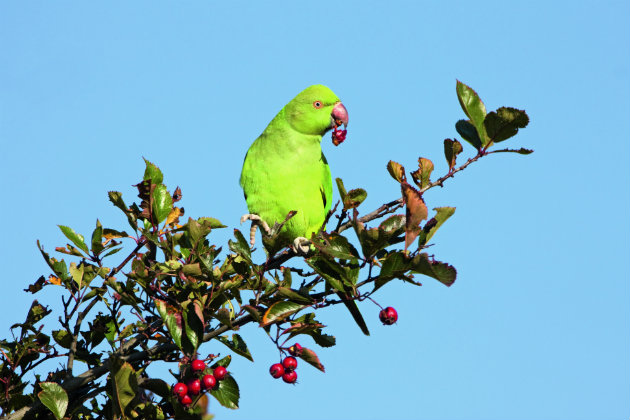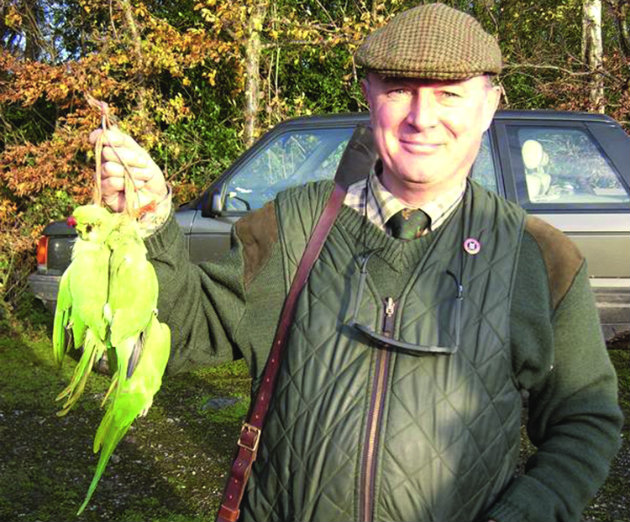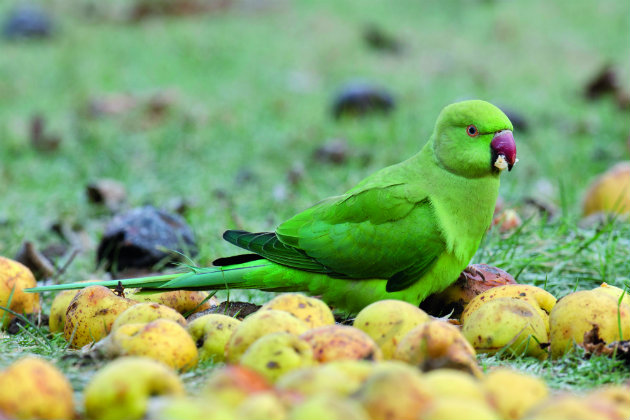Win CENS ProFlex DX5 earplugs worth £1,149 – enter here
Why green parakeets are now on the General Licence

On a Surrey farm where I help control pests, there is a magical moment every evening. It’s as regular as clockwork and occurs near dusk. The only warning is distant high-pitched squawks “kyik… kyik … kyik”. Regular shooters know the drill and swiftly duck behind some cover and turn to the farm’s South East corner, shotguns up and ready. They are coming.
Blink and you will miss them. Within seconds, scores of bright green arrows flash overhead, squawking like crazy, tightly packed, tall hedge height, and going like the clappers. With a loud whoosh that threatens to remove your cap, they are gone. Two or three Guns can usually drop a brace or two out of the flock, but it is far from easy. The shot is pure instinct; there is no time for analysis. Driven grouse are tame by comparison.
Green parakeets included on the General Licence
The quarry are ring-necked parakeets (also known as rose-ringed parakeets). In 2010 DEFRA and Natural England finally acknowledged the destructive potential of these emerald invaders and gave shooters authorization to cull them. The parakeets were included on the General Licence (GL04) permitting them legally to be shot to prevent damage to crops, vegetables and fruit.
On the farm in question, a huge roost has been moved on and the parakeets’ attacks have been successfully discouraged. The damage they did had to be seen to be believed. The blighters would take a bite or two out of each apple before moving on to the next. In no time at all, an entire stand of apples was rendered unfit for sale.

Parakeets were included on the General Licence in 2010 to protect crops
The astonishing thing is that it took DEFRA so long to acknowledge the agricultural threat posed by these invaders, given that their numbers first started to increase dramatically during the 1990s. Before parakeets were put on the General Licence, our farmer had to go cap in hand for special permission to cull them. Initially, we were granted permission to “shoot to scare” (which predictably made no impact) and then finally told we could shoot just 30 parrots a year. This at a time when a roost of many hundreds descended daily to pillage the farm’s crops. DEFRA’s foot-dragging was all the more surprising given the response of other nations to the green invaders. For example, Australian authorities having seen a mere handful of green parakeets immediately recognised that these birds posed an “extreme threat” to agriculture (more so due to the warmer antipodean climate). They issued a Pest Alert calling for states to implement control programmes to remove parrots spotted in the wild.
Listed among the top 100 worst alien species
At last they are now being taken seriously in the UK (although some seasoned observers think it is already too late – like grey squirrels, their beachhead has become too strong and too widespread). The latest initiative is an 18 country parrot monitoring scheme, run by Dr Jim Groombridge at the University of Kent (see below). According to Dr Groombridge rose-ringed parakeets are now listed among the top 100 worst alien species in Europe. Since the 1970s, they have rapidly established in over 100 cities across the continent and beyond. They pose problems in both urban and rural areas including potential to transmit diseases to livestock and humans, competition with native wildlife and, increasingly, as an agricultural pest.

Females (shown here) have an indistinct emerald neck-ring; males have a small black ring beneath the bill that extends back across the neck as a thin black line borded by pink or orange, as well as a blue sheen on rear of crown
The Non-Native Species Secretariat (NNSS) of DEFRA has acknowledged that the population of ring-necked parakeets is increasing exponentially and that these birds can raid many crops including maize and other cereals as well as orchards and vineyards. They can also carry diseases such as Newcastle disease and Cryptosporidium, with potential for them to pass infections to poultry, seriously impacting on that industry. DEFRA estimates that in order to reverse the population growth an annual cull of at least 30 per cent of the total population would be required. “Although this is feasible given the will and the resources, such a campaign would be necessarily visible to the public and as such may prove controversial,” admits a DEFRA report. Most parrot flocks occur in southern counties, however they have been reported in Scotland.
Rose-ringed parakeets are listed under Schedule 9 to the Wildlife and Countryside Act 1981 making it an offence to release or to allow the escape of this species into the wild (several countries now ban the keeping of green parrots as pets, due to the risk of escape). Given this, it is surprising that they are freely for sale on Internet sites such as Gumtree. And given their bite, it
is unsurprising that they regularly escape from, or are set free by, mauled owners.
Do not let a dog retrieve parakeets
A final word of warning on the same theme; never let your dog go to retrieve a shot green parrot. They have a nasty bite. I’ve heard of one putting its beak through a strong boot.
How you can help
Green parakeets have spread across Europe and are now established in UK. A team of researchers from the University of Kent says that readers can help track the spread of this non-native species.
If you shoot a green parakeet whilst controlling pests, please remove a wing feather and forward this to the research team. Put the feather in a ziplock bag or envelope together with a short note stating where and when it was culled (Postcode, address or map reference).Send the feather to:
Dr Jim Groombridge, Reader in Biodiversity Conservation, Durrell Institute of Conservation and Ecology (DICE), School of Anthropology and Conservation, University of Kent, Canterbury, Kent CT2 7NR. Genetic analysis of the feather will enable researchers to track the source and spread of parrot populations. Dr Groombridge would also like to hear from anyone has who lives near a parakeet roost or from farmers who see parakeets regularly on their land, particularly if these are damaging crops.You can email Jim and his team at parrotnet@kent.ac.uk. ParrotNet is an EU project that involves 18 countries to track the growing populations of green parakeets across Europe.
If you shoot a green parakeet whilst controlling pests, please remove a wing feather and forward this to the research team. Put the feather in a ziplock bag or envelope together with a short note stating where and when it was culled (Postcode, address or map reference).Send the feather to:
Dr Jim Groombridge, Reader in Biodiversity Conservation, Durrell Institute of Conservation and Ecology (DICE), School of Anthropology and Conservation, University of Kent, Canterbury, Kent CT2 7NR. Genetic analysis of the feather will enable researchers to track the source and spread of parrot populations. Dr Groombridge would also like to hear from anyone has who lives near a parakeet roost or from farmers who see parakeets regularly on their land, particularly if these are damaging crops.You can email Jim and his team at parrotnet@kent.ac.uk. ParrotNet is an EU project that involves 18 countries to track the growing populations of green parakeets across Europe.
Related Articles
Get the latest news delivered direct to your door
Subscribe to Shooting Times & Country
Discover the ultimate companion for field sports enthusiasts with Shooting Times & Country Magazine, the UK’s leading weekly publication that has been at the forefront of shooting culture since 1882. Subscribers gain access to expert tips, comprehensive gear reviews, seasonal advice and a vibrant community of like-minded shooters.
Save on shop price when you subscribe with weekly issues featuring in-depth articles on gundog training, exclusive member offers and access to the digital back issue library. A Shooting Times & Country subscription is more than a magazine, don’t just read about the countryside; immerse yourself in its most authoritative and engaging publication.







